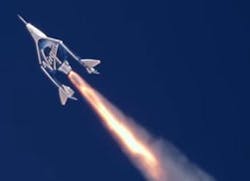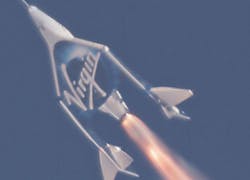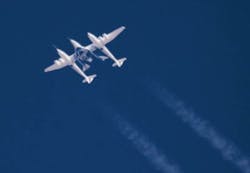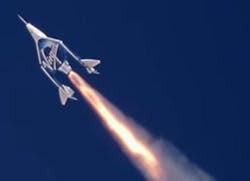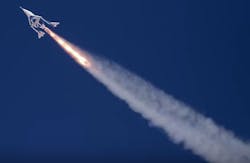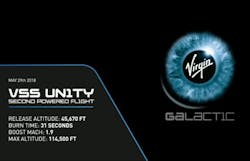Virgin Galactic, The Spaceship Company test supersonic, rocket-powered VSS Unity commercial spacecraft
MOHAVE, Calif. Teams from Virgin Galactic in Las Cruces, New Mexico, and The Spaceship Company in Mohave, California, again put the VSS Unity rocket-powered, supersonic spaceplane through its paces, during a second test flight, on the path to entering commercial service this week. Roughly two months after the first test flight, VSS Unity took to the skies at the Mojave Air and Space Port, a civilian aerospace test center, in Mojave, California.
VSS Unity is a SpaceShipTwo-class, suborbital, rocket-powered, manned spaceplane manufactured by The Spaceship Company for Virgin Galactic.
The goal of the flight test was “to expand our understanding of the spaceship’s supersonic handling characteristics and control system’s performance with vehicle parameters that were closer to the ultimate commercial configuration,” officials say. The engineering team added passenger seats and related equipment, which shifted the unique space vehicle’s center of gravity rearward.
Virgin Galactic’s VMS Eve, a WhiteKnightTwo carrier mothership and launch platform, carried the VSS Unity spaceplane to the skies. Upon release from VMS Eve, the pilots fired up VSS Unity’s rocket motor, which burned for the planned 31 seconds and propelled Unity to a supersonic speed of Mach 1.9 and an altitude of 114,500 feet.
Pilots deployed Unity’s unique re-entry feathering system to start the initial descent, after which the craft made its final glide home to a smooth runway landing – the same way future commercial flights will be conducted.
Founder Richard Branson joined Virgin Galactic and The Spaceship Company teams on the Mojave Air and Space Port flight line, to witness VSS Unity’s second successful, supersonic, rocket-powered test flight.
The hybrid (nitrous oxide/ TPB compound) rocket motor, which was designed, built, and tested by The Spaceship Company, powered Unity through the transonic range and into supersonic flight for the first time.
“It was great to see our beautiful spaceship back in the air and to share the moment with the talented team who are taking us, step by step, to space,” Branson said following the flight. “Seeing Unity soar upwards at supersonic speeds is inspiring and absolutely breathtaking. We are getting ever closer to realizing our goals.”
Once in commercial service, Virgin Galactic’s spaceships are designed to be turned around and flown at a higher frequency than has traditionally been the case for human spaceflight.
“Great credit goes to the engineering and maintenance teams for working through the first flight’s data diligently and efficiently before preparing Unity again for flight,” officials say.
Branson recognized VSS Unity pilots Dave Mackay and Mark “Forger” Stucky, as well as CJ Sturckow and Nicola Pecile, who piloted VMS Eve, the carrier aircraft.
“Today we saw VSS Unity in her natural environment, flying fast under rocket power and with a nose pointing firmly towards the black sky of space,” Branson said. “The pathway that Unity is forging is one that many thousands of us will take over time, and will help share a perspective that is crucial to solving some of humanity’s toughest challenges on planet Earth.”
The teams will now conduct flight data review for this second test flight and continue planning the next flight.
Unity is the first vehicle to be built from scratch for Virgin Galactic by sister manufacturing organization The Spaceship Company’s team of aerospace engineers and technicians.
While in Mojave, Richard Branson also toured the facilities of The Spaceship Company (TSC), Virgin’s Galactic sister company. TSC is focused on manufacturing next-generation aerospace vehicles, with a primary focus on new spaceships for Virgin Galactic’s future fleet. Branson viewed the next two spaceships on the TSC’s manufacturing line, as well as the production facilities for TSC’s spaceship rocket motors.
The first supersonic, rocket-powered flight, earlier this year, followed two years of extensive ground and atmospheric testing. VSS Unity benefits from all the data and lessons gathered from the test program of her predecessor vehicle, VSS Enterprise. The first flight saw an envelope expansion for the program as a whole in terms of rocket burn duration, speed, and altitude achieved, officials say.
Unity is in the final portion of its flight test program.
